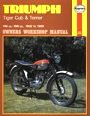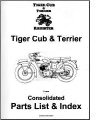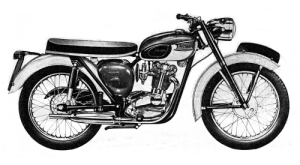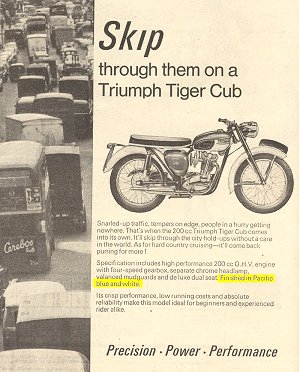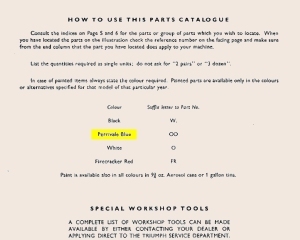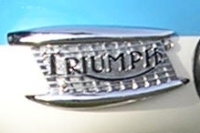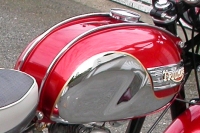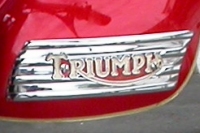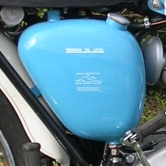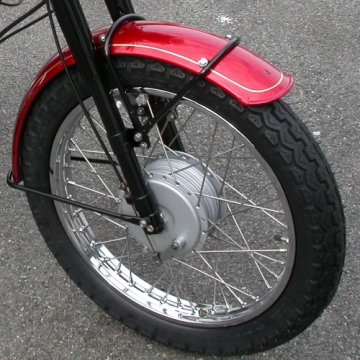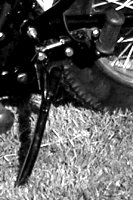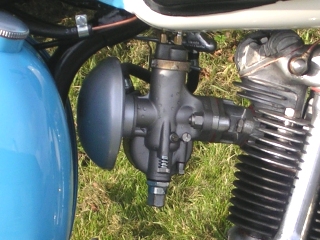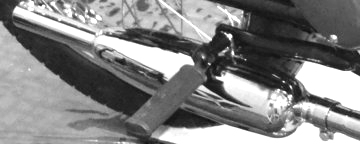Rebuilding Triumph T20B Bantam Cubs
Rebuilding & restoring the T20B variant of the Triumph Tiger Cub
|
Bantam Cubs are very simple machines by today's standards and restoring them is pretty straightforward. However, because they're relatively rare models of Tiger Cub it can be difficult to identify and source some of the components, especially if you're aiming for an accurate restoration. The notes below are based on my personal experiences and the research I carried out while rebuilding my own bike. I hope you will find them useful. |
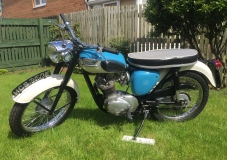 
|
The BSA Influence
|
When I started to rebuild my 1967 Triumph Bantam Cub I didn't realise at first just how significant BSA was with these models. Although branded a Triumph, virtually everything on the bike apart from the engine and tank badges is BSA! The T20B Bantam Cubs and Super Cubs were based on the BSA Bantam D7 and D10 respectively. With the exception of the petrol tank, the front mudguard and the wheels, the two T20B models are almost identical to each other. Both models also have a similar appearance to the Bantam D14 and the B175. When originally manufactured, many parts were used from other BSA models, plus a few are specific to the T20B. For example, the oil tank was from the BSA C15 and the side stand from the Bushman version of the Bantam, while the petrol tanks and headlight are unique. So, other than the engine, when you're searching for original parts, think BSA! |
|
Before You Start
Before starting a rebuild I would recommend these publications, especially the three on the left - they really are essential.
|
The Tiger Cub Bible, by Mike Estall - a really useful reference book covering all Cub models. |
Roebuck Zeus Data Charts - a booklet with engineering data that includes useful thread details. It does not cover all types of thread used on Cubs, but is still very helpful when trying to identify nuts, bolts and screws. |
||
|
A copy of the original Triumph Parts Book for the Bantam Cub & Super Cub - these are readily available via websites like eBay and from suppliers of Tiger Cub parts. |
The Haynes Manual for the Tiger Cub - this does not give much detail that is specific to the T20B, but it does have useful information and pictures of the Cub engine assembly. |
||
|
Mike Estall's Consolidated Tiger Cub Parts List - this gives useful sizes and references not covered in the Parts Book. These used to be available directly from Mike Estall himself, but sadly he passed away in 2017. Updated availablity to follow. |
The Haynes Manual for the BSA Bantam - a thin book that covers more than a dozen models so it's a bit light on detail. Also, the only sections relating to T20B are the frame, forks, wheels, brakes and electrics. Personally I didn't find it a lot of help, but there are a few useful specifications. |
How Bantam Cubs Differ
Both the Triumph Tiger Cub and the BSA Bantam are well documented elsewhere so I've just summarised below the main areas where the Bantam Cub and Super Cub differ from the more common models.
|
|||
|
|
|
||
|
Triumph T20B Bantam Cub, 1966-68 |
Triumph T20B Super Cub, 1967-69 |
||
Paintwork
|
Bantam Cubs were supplied in a two-tone, blue and white colour scheme - 'Nutley Blue' (see notes below) which is a BSA colour and 'Alaskan White', a widely-used Triumph colour. Super Cubs were finished in a BSA red known as 'Firecracker Red' (see notes below). The petrol tank was chromed before the top half was painted, leaving the chrome exposed on the bottom half. Both models had gold lining on the front mudguards - see pictures in the 'Wheels' section below.
Bantam Cub Colour Notes The Parts Book, mentions 'Perrivale Blue', but I can't trace any evidence of that name being used in production. Also, shouldn't it have been spelt Perivale Blue? A 1966 advert describes the machines as being 'Finished in Pacific blue and white'. Pacific Blue was a colour that was used on some Triumph Twins of that era and it does look like it could have been the same as Nutley Blue. Was Triumph simply re-branding BSA's Nutley Blue to differentiate their colours from BSA? Some modern, Hinckley Triumphs are also available in a colour known as Pacific Blue, but this is quite different from the colour of the same name used in the 1960's and 70's. Super Cub Colour Notes |
|
Back to top of page
Back to list of 'How Bantam Cubs Differ'
Petrol Tank
|
The Bantam Cub petrol tank is based on the Bantam D7, and the Super Cub on the Bantam D10. The two tanks are completely differerent shapes and in both cases the T20B versions are not exactly the same as the original BSA models because of the difference between the Triumph and BSA badges. BSA tanks tend to have recesses on either side of the tanks to take the BSA badges. However, the Triumph badges sit on the surface and follow the contours of the tanks. Consequently the T20B tanks have no recesses for badges and instead have threaded holes in the correct positions for the Triumph badges. This means that although all the tanks are physically interchangeable, if you want the right shape, with the right Triumph badge, then you'll need the correct tank for your bike - there are no alternatives from other models. These tanks are still available, but are becoming quite rare now so expect to pay a high price for a good one. The Triumph tank badges (referred to as 'styling units' in the parts book) are also different for each model. The Bantam Cub used the popular 'mouth organ' style found on many Tiger Cubs while the Super Cub had the later two-piece badge. Only the Bantam Cub had rubber knee pads fitted to the tank. The Bantam D7, D10 and the Super Cubs had no knee pads. |
|
|
Back to top of page
Back to list of 'How Bantam Cubs Differ'
Oil Tank & Oil Filter
|
The BSA Bantam used a two-stroke engine so there was no need for an oil tank. Consequently the Bantam's right-hand side panel was almost a mirror-image of the left-hand battery box cover. However, the Tiger Cub engine is, of course, a dry-sump four-stroke so an oil tank was needed. On both models of T20B, BSA used the oil tank from their latest C15 model which was a 250cc, four-stroke. Some earlier C15 oil tanks are the correct size and shape, but they don't have the 'froth tower' projecting from the top of the tank where the breather pipe connects. The version fitted to the T20B seems to have appeared on the C15 in the mid-1960's, around the same time as the T20B was introduced. Did the T20B simply use the latest design that had evolved for the C15, or did the C15 benefit from improvements developed for the introduction of the T20B? Whatever the reason, if you need a replacement you may find that oil tanks described as 'C15' are cheaper than those with a 'Bantam Cub' or 'Super Cub' label. Provided you get the later version with the froth tower, they are all the same BSA part. (Part number 75-8345.) A very simlar tank was also used on BSA's 350cc model B40 and this may also be suitable. (Part number 40-8302.) The oil filter in the bottom of the oil tank is a widely used BSA/Triumph part. The original oil filter part number F3179 is equivalent to 82-3179 and 40-8328. Replacements are readily available at reasonable prices so shop around. |
|
Back to top of page
Back to list of 'How Bantam Cubs Differ'
Front Mudguards
The Bantam Cub uses a common mudguard fitted to both the standard Tiger Cubs and many Bantams from D7 onwards. It has integral flat brackets that bolt to the fork legs and four identical, straight stays to secure it front and back.
The Super Cub appears to use a Triumph mudguard that was fitted to the Sports Cubs, Scramblers and Mountain Cubs. It also looks very similar to the mudguards used by many of the bigger Triumphs such as the Bonneville and Daytona. It is attached to the forks by three steel hoops.
See pictures in 'Wheels' section below.
Back to top of page
Back to list of 'How Bantam Cubs Differ'
Wheels
The Bantam Cub uses Bantam D7 wheels. On both the front and rear hubs, the side opposite the brake is smaller in diameter than the brake side meaning the spokes are different lengths on each side.
The front wheel is identical to 18 inch T20 wheels. Although the rear wheel looks very similar to standard Cubs, the Bantam hub is approxiamtely 10mm wider which means that neither the rear hubs nor the spindles are interchangeable with other Cubs!
The Super Cub uses the Bantam D10/D14/B175 wheels with 'full-width' hubs front and rear. These are the same diameter on both sides with a corrugated centre and they have spokes of the same length on both sides. If you are restoring these hubs then take care as the corrugated sleeve is quite thin and, if corroded, it can be severely damaged by shot-blasting.
|
Identifying Front Wheels and Mudguards |
|
 |
|
|
T20B Bantam Cub Wheel & Mudguard |
T20B Super Cub Wheel & Mudguard |
Back to top of page
Back to list of 'How Bantam Cubs Differ'
Headlight , Speedo & Switches
As far as I can establish, this particular headlight was only ever fitted to the T20B. It is based on the Lucas MCH56 shell and is chromed. Other versions of the MCH56 shell do exist, but the sizes and positions of the holes for the speedo, switches, etc, seem to be unqiue to this model.
Some late Bantams and a few C15 Sportsman models did have a similar headlight, but these were made by Wipac and have slightly different proportions. The Wipac shell is shorter and looks fatter than the Lucas version and the rim is thicker. Most importantly the Wipac model is made for a larger diameter speedo so they are not interchangeable, unless you are willing to swap the speedo and accept that the appearance will not be original.
The T20B had the same Smiths SSM2001 speedo (2-3/8" diameter, 0-80mph) and separate Lucas SA88 ignition and lighting switches as fitted to other late Tiger Cubs. This differs from many of the Bantams which used Wipac switches and 2-1/2" diameter speedo, although later D10 and D14 models did use the same speedo.
As a consequence you can expect to pay a high price for a good, original T20B headlight!
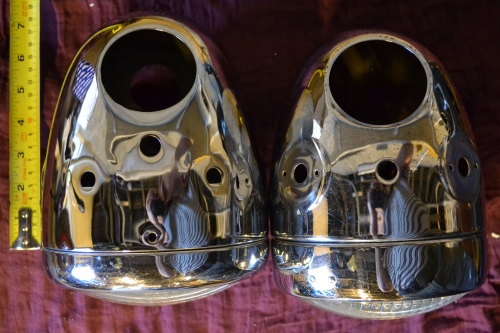 |
Identifying Headlamp Shells - Top View. Left: Correct T20B Lucas headlamp. Right: Similar BSA Wipac headlamp. |
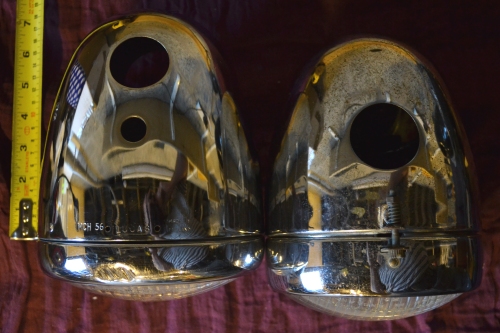 |
Identifying Headlamp Shells - Bottom View. Left: Correct T20B Lucas headlamp. Right: Similar BSA Wipac headlamp. |
For more details of the electrical equipment fitted to Bantam Cubs and Super cubs see the 'Electrical' page.
Back to top of page
Back to list of 'How Bantam Cubs Differ'
Handlebar Controls
The T20B handlebars are standard Bantam D7/D10/D14/B175. However, the levers and twist-grip are different. If you're not concerned about historical detail then any 7/8" levers and twist-grip will do. If you're going for accuracy then these will be difficult to get right. The T20B used an unusual Amal set-up with the brake-lever and twist-grip combined in a single assembly. The clutch lever used a cast bracket that matches.
|
A similar set-up was also used on some Ariels - I believe certain Arrows and Leaders were fitted with them. However, most of the Ariels used plain levers while the T20B had ball-end levers. Also, the T20B used the standard 4-3/4" long Amal rubber grips while some Ariels used a shorter, 4" version meaning that, although the bulk of the assembly is identical, the length of the steel throttle tube differs in length. Finally the Ariel parts were usually painted grey while the T20B versions were chromed. Therefore, if you want an authentic restoration it can take a while to track down the right parts. Ariel parts may be used as short-term substitutes while you search for the correct originals. |
T20B controls & similar Ariel controls |
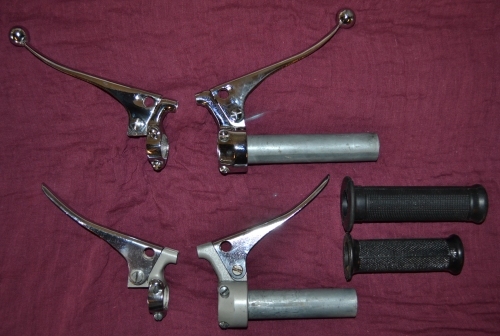 |
Identifying Amal combined controls. Top: Correct T20B controls. Bottom: Similar Ariel controls. |
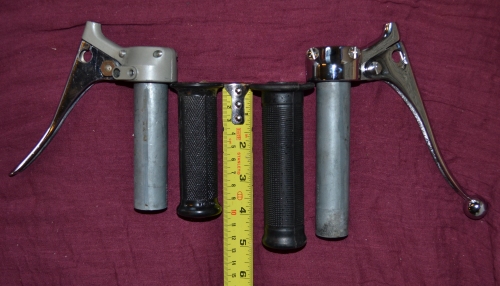 |
Identifying Amal combined throttle assemblies. Left: Ariel controls. Right: Correct T20B controls. |
|
|
Identifying Amal levers. Top: Standard Amal Levers - not suitable for T20B These levers are readily available from many suppliers,
but do NOT fit the original T20B set-up. They won't fit the brackets
properly and the cable will be too tight with no slack for adjustment. Middle: T20B Levers Bottom: Ariel Levers - alternative for T20B |
Back to top of page
Back to list of 'How Bantam Cubs Differ'
Seat
The steel base for the seat on the T20B was common for both models and is standard Bantam D7/D10/D14/B175 base. However, there were variations in the colour of the seat covers and in the thickness of the seat cushions.
Photos and drawings from the period suggest that the original colours and sizes were as shown in the table below, but I have not yet been able to verify these and several other styles exist.
|
T20B Model |
Part No. |
Seat Top |
Seat Sides |
Top Piping |
Base Edging |
Pillion Strap |
Cushion |
|
Bantam Cub |
75-9164 |
Grey |
Black |
White |
Grey |
Not fitted |
2 inch thick |
|
Super Cub |
71-9171 |
Black |
Black |
White |
Black |
Black |
3 inch thick |
|
|
New seat covers and even complete seats are readily available for Bantams, but can be expensive. The original Bantam Cub covers with the grey top and no strap are incredibly rare! Standard Cub seats are available with the grey top but they are, of course, designed to fit the Cub seat base and not the Bantam base, which is a completely different shape. |
Back to top of page
Back to list of 'How Bantam Cubs Differ''
Frame & Engine Mounts
|
The T20B machines use standard BSA Bantam frames. The only difference is the addition of an extra engine mounting point. The Bantam engine has just two engine mounts - one at the front and one at the back. The more powerful Cub engine has a third mounting point underneath the front of the engine. As a result, the T20B frames differ from the standard Bantam frames with an extra engine mount. The two plates used to connect the rear of the engine to the frame are also quite different from the standard Bantam plates. These are uinqie to the T20B. |
|
Back to top of page
Back to list of 'How Bantam Cubs Differ'
Footrests
The front footrests on a BSA Bantam sweep up and out from their mounting points on the frame under the engine. However, the Cub engine is larger than the Bantam and so the footrests are different to avoid the outer casings. The T20B footrests come out horozontally and are then stepped up.
The pillion footrests on the T20B were fitted with the standard Bantam rubbers complete with the 'BSA' logo embossed on either side! Note that BSA produced two similar versions of these pillion rubbers for a wide range of different machines. The T20B uses the shorter, 3-1/2" version, not the longer ones that are 4-1/4".
The bracket for the left-side pillion footrest differs from the standard Bantam D7/D10 bracket. As discussed below in the 'Side Stand' section below, this bracket is the same as the Bantam 'Bushman' models to accommodate the side stand.
Back to top of page
Back to list of 'How Bantam Cubs Differ'
Side Stand
|
Frequently BSA Bantams relied on just a centre stand. Where a side stand was fitted, it was usually attached to the two front engine mount bolts. Alternatively some owners fitted a common after-market stand that clamped to the frame underneath the engine. Neither of these options were possible on the T20B because the front mount on the Cub engine only has a single bolt and the larger size of the engine means there is not enough room between it and the frame for a clamp. Around the same time as the Bantam Cub was introduced in 1966, BSA launched their 'Bushman' model of the Bantam and both machines shared a new side stand. This was bolted onto a re-designed bracket for the left-side pillion footrest. It's not clear whether the introduction of the Bantam Cub prompted the re-design and this was adopted by BSA for their own new model, or if the stand was already in place for the Bushman and it offered a simple solution for the Bantam Cub too. Either way, the Bushman and both T20B models used the new design and they are therefore different from other Bantams and Tiger Cubs. |
|
Back to top of page
Back to list of 'How Bantam Cubs Differ
Engine
The engine is almost entirely a standard, late-type, T20 engine with points on the side, ball bearings fitted in both main bearings and the distinctive square barrel and head.
The Triumph Parts Books shows a roller big-end bearing fitted to all T20B engines, but this is not accurate! Most T20B engines did have the roller big-end, but early models came off the production line with the earlier plain bush big-ends. I'd be surprised if any of these plain bushes survive as this was a well-documented weak point. Most will have been replaced with Alpha roller bearing kits at least once in their lifetime.
The only difference with the main engine components fitted to the T20B appears to be that the engine number is stamped on the left-hand casing below the bottom of the barrel rather than on the front engine mount. (Is this a Small Heath trait perhaps?) Engine numbers all start T20B and would have originally matched the frame number exactly.
There are a few differences with some of the peripheral engine components as detailed below.
Back to top of page
Back to list of 'How Bantam Cubs Differ'
Carburettor & Air Filter
|
Both models of T20B were fitted with an Amal Monobloc 375 carburettor fitted with a 'mushroom' air filter. Numerous versions of the Amal 375 Monobloc were produced, but the specific model to look for is stamped with the number '375/61' on the top of the flange. This has the correct 25/32" (19.8mm) bore and the right thread for the filter which is 1-7/16" (36.5mm) diameter x 24 tpi (threads per inch). Note that there is an error in the original Triumph T20B Parts Book. The carburetter is detailed on pages 52 and 53 and the illustration shows Ref. No. 6, 'Mixing Chamber Top' (375/064) with a single cable-entry hole on a sloping top. This is not accurate because that part actually has a square top with two cable-entry holes. Also, the parts book does not show either the Cable Adjuster Screw (4/035) or the Plug Screw (4/137A) used to blank off the unused hole. The same parts were fitted to 375 carbs on other machines and the Amal drawing opposite almost certainly shows the correct parts fitted to the T20B. Although not shown in the illustrations, Amal also supply a Nut (5/077) which may be used to lock the cable adjusting screw. This is a sensible addition to prevent the screw turning by itself. Many of the more common models of Tiger Cub used an air filter mounted under the seat next to the oil tank and this was connected to the carburettor via a rubber tube that fitted over a lip on the carb inlet. However, the Bantam tinware didn't permit this set-up and so instead the T20B used a mushroom-shaped filter screwed onto the inlet. Similar mushroom filters were used on several bikes of that era, but they all seem to be bigger and I can't find details of any other model that used this exact part. As you can see from the photo, it's a pretty tight fit and it seems likely the filter was designed specifically for the T20B. The pressed-steel bodies are still available, but the internal filter element is now very difficult to find.
|
|
|||||||
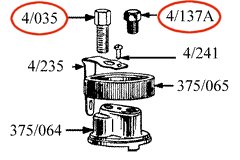
Parts for top of Amal 375/61 carb. |
Back to top of page
Back to list of 'How Bantam Cubs Differ'
Kickstart
The kickstart on the T20B is very slightly different from the standard Cubs. The difference is almost imperceptible, but it is important! Because the T20B exhaust pipe follows a different route to the standard Cubs (see below) there is a tendency for the kickstart to hit the exhaust. The problem is exacerbated by some manufacturers of replacement exhausts who appear to be using 35mm metric tubing which is marginally bigger than the original imperial size of 1-5/16".
There is therefore a different version of the kickstart for the T20B that curves slightly further out from the engine (part number T1679 for the complete assembly). The difference is small so unless you have a standard kickstart to compare it with, it can be difficult to determine that you have the T20B version.
New, pattern parts are available from some suppliers, but originals are hard to find mainly because they appear so similar to the standard version.
Back to top of page
Back to list of 'How Bantam Cubs Differ'
Exhaust Pipe
At first glance the T20B exhaust pipe and silencer appear to be similar to the standard Tiger Cub, but there are some subtle differences that mean they are not interchangeable!
The standard Cub exhaust sweeps down under the engine and is tucked in close to the frame; the standard silencer bulges outward from the bike.
However, on the T20B the shape of the frame prevents the exhaust following the same route. The pipe has an outward kink to push it slightly further out and clear of the frame. The silencer looks similar to the standard Cub silencer, but it bulges inward towards the back wheel. Both components are unique to the T20B.
This means that the standard Cub exhaust system cannot be used on a T20B - if you have problems getting your exhaust to fit properly, check you have the correct one.
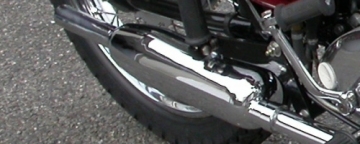 |
|
|
T20B |
Standard T20 |
Back to top of page
Back to list of 'How Bantam Cubs Differ'
Wiring Loom & Horn
The same wiring loom is used for both T20B models. This is very similar to the Bantam D10 loom and also late, standard, T20 Tiger Cub looms. The only significant difference seems to be the location of the horn. The BSA Bantams and the majority of T20 Tiger Cubs had the horn mounted under the seat near the battery, but the T20B horn hangs down under the front of the petrol tank. The Bantam D7 loom will not fit either model!
See additional infromation on the 'Electrical' page.
Back to top of page
Back to list of 'How Bantam Cubs Differ'
Questions about Tiger Cubs? Why not try
some of the independent forums such as:
Tiger Cub &
Terrier | The
Triumph Forum | Triumph
Rat Forum | or others.
Boring legal bit... All information on this
website is provided in good faith. The accuracy of the information cannot be
guaranteed.
No responsibility can be accepted for any consequence arising from the use of
this website. You must independently verify all information..
The owner of this website has no connection with or interest in any organisation
mentioned except as a customer or casual subscriber.
Copyright © 2011-2023






